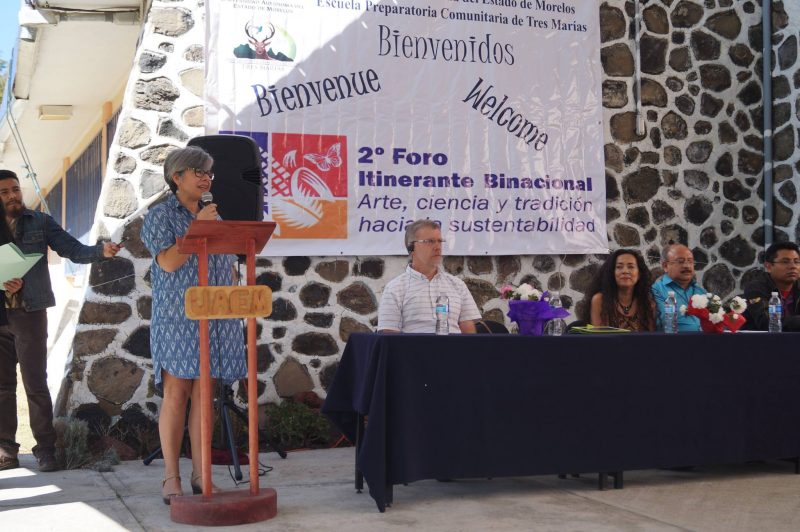The second day of the Arts, Science and Tradition for Sustainability forum (March 15, 2016) started under the beautiful Cuernavaca sun. Our journey took us to the rural campus of the Tres Marias Preparatoria school in the Municipality of Huitzilac in the heart of the Corredor Biológico Chichinautzin. The school showcased the science, arts and traditions of the region in an exemplary way.
The Tres Marias Prepa is a community school that is part of the Universidad Autónoma del Estado de Morelos (UAEM), and is a school bridging between the high school and university education levels, not unlike our very own CEGEP. The school has two main areas of study, forest management and sustainable community development while fostering and encouraging practical environmental involvement and social responsibility. The student population of the school is primarily composed of students living in the neighboring rural communities, some of which identify as being Indigenous.
Dawson College, UPEMOR, UAEM and Ciudades Verdes’ representatives were greeted with a heartwarming ceremony, where local students read a beautiful poem celebrating the richness, strength and fragility of nature and the importance of sustainability. After a few words from the Director of the school, Jorge Alberto Viana Lases, a representative of the Director of the UAEM, Luisa Montes and Dr. Gisela Frias, we were invited to exchange with senior students. The soon to be graduates presented their final theses projects. All the projects presented were brilliant examples of innovative sustainable technologies that addressed local rural challenges. The students showcased research projects on composting; heating using solar reflection and rudimentary recycled materials; techniques for rainwater collection and transportation; and optimization of foresting technologies.
The Tres Maria students created an art/environmental education workshop that uses solely recycled materials and are sharing this knowledge with local elementary and high schools. Sophmore students taught us about the biodiversity of the Morelos region and the contamination challenges that it faces. The students are going through great lengths and are engaged in a complex legal process to have their area recognized as an “environmental management unit”, an ecological haven for the white tailed deer, an indigenous endangered species.
After the very informative science exposition session, we were invited to a tasting of local food that was generously and lovingly prepared by the student’s parents and included traditional meals such as Barbacoa a lamb based meal cooked in a terracotta container 60 m underground and Pulque a pre-hispanic fermented drink that used to be reserved to high ranking officials, but that is now a popular and deliciously flavoured drink.
Following the ample feasting, the local students along with UPEMOR and Dawson college students gathered in the main outdoor area to play a series of games aiming at creating connections and promoting cultural exchanges. Meanwhile, the forum organisers, instructors and administrative staff were invited to learn about Dawson’s living campus initiative presented by Chris Adam.
Students and non-students gathered again at the end of their respective activities to witness a magnificent spectacle of artistic expression and tradition. This display included singing rap performances by Dalton Stewart, a Dawson student, and Miguel a Tres Marias student, exploring the reality of ecological fragility. The show also included pre-hispanic choreography as well as a dancing display of traditional Chinelos, a costumed caricature of colonialists that has blended into local Mexican identity and became an integral part of Morelos’ carnivals. The session culminated in a collective joyous dance involving all the participants as well as the Tres Marias students and non-student personnel.
The generosity of the Huitzilac community is without parallel and is truly humbling. The Tres Marias school is the embodiment of living campus, as their facilities are embedded in picturesque setting. Their mission is to research and advance environmental understanding and knowledge while nurturing human connectivity to social responsibility.
By Selma Hamdani




